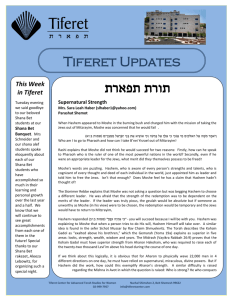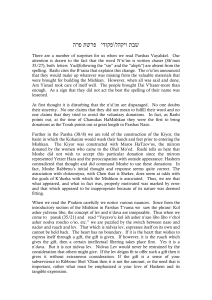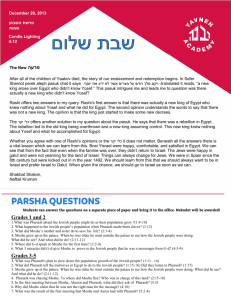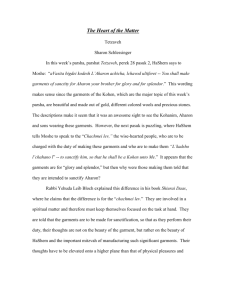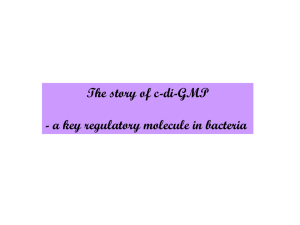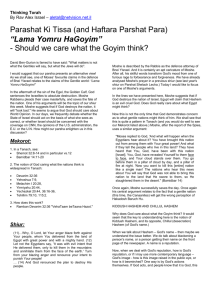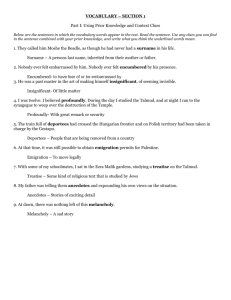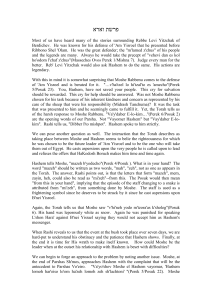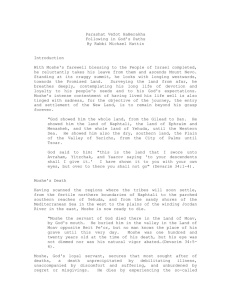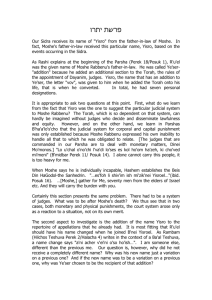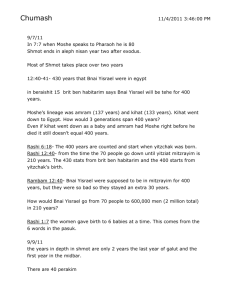Shemot
advertisement
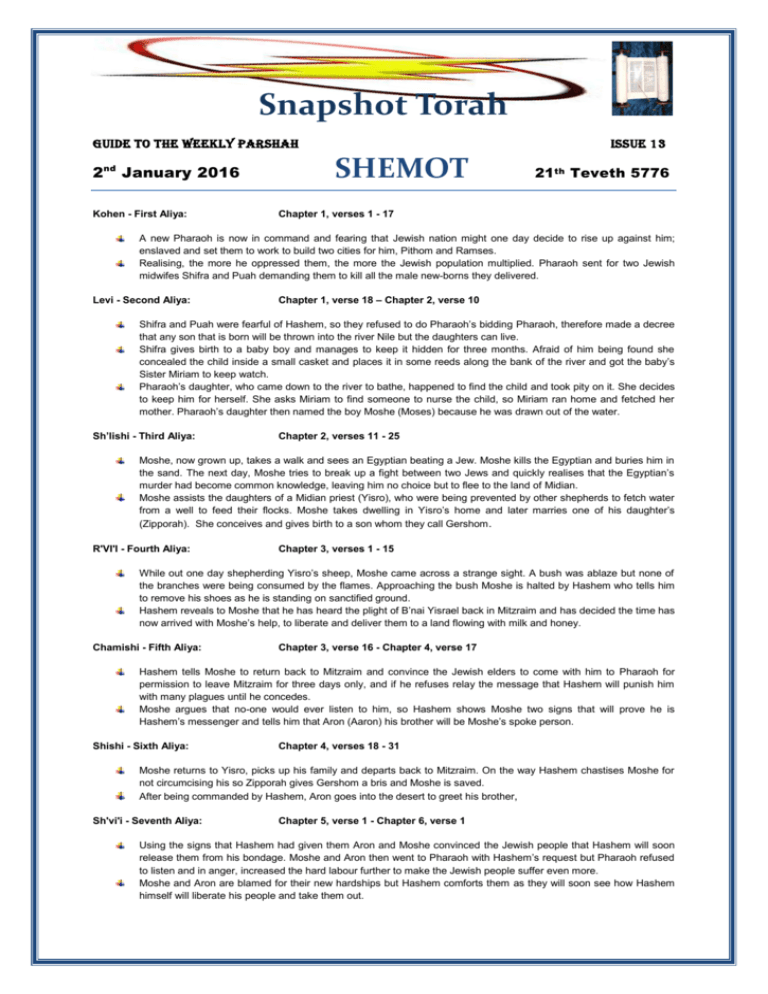
Snapshot Torah Guide to the weekly parshah 2nd January 2016 Kohen - First Aliya: ISSUE 13 SHEMOT 21th Teveth 5776 Chapter 1, verses 1 - 17 A new Pharaoh is now in command and fearing that Jewish nation might one day decide to rise up against him; enslaved and set them to work to build two cities for him, Pithom and Ramses. Realising, the more he oppressed them, the more the Jewish population multiplied. Pharaoh sent for two Jewish midwifes Shifra and Puah demanding them to kill all the male new-borns they delivered. Levi - Second Aliya: Chapter 1, verse 18 – Chapter 2, verse 10 Shifra and Puah were fearful of Hashem, so they refused to do Pharaoh’s bidding Pharaoh, therefore made a decree that any son that is born will be thrown into the river Nile but the daughters can live. Shifra gives birth to a baby boy and manages to keep it hidden for three months. Afraid of him being found she concealed the child inside a small casket and places it in some reeds along the bank of the river and got the baby’s Sister Miriam to keep watch. Pharaoh’s daughter, who came down to the river to bathe, happened to find the child and took pity on it. She decides to keep him for herself. She asks Miriam to find someone to nurse the child, so Miriam ran home and fetched her mother. Pharaoh’s daughter then named the boy Moshe (Moses) because he was drawn out of the water. Sh’lishi - Third Aliya: Chapter 2, verses 11 - 25 Moshe, now grown up, takes a walk and sees an Egyptian beating a Jew. Moshe kills the Egyptian and buries him in the sand. The next day, Moshe tries to break up a fight between two Jews and quickly realises that the Egyptian’s murder had become common knowledge, leaving him no choice but to flee to the land of Midian. Moshe assists the daughters of a Midian priest (Yisro), who were being prevented by other shepherds to fetch water from a well to feed their flocks. Moshe takes dwelling in Yisro’s home and later marries one of his daughter’s (Zipporah). She conceives and gives birth to a son whom they call Gershom . R'VI'I - Fourth Aliya: Chapter 3, verses 1 - 15 While out one day shepherding Yisro’s sheep, Moshe came across a strange sight. A bush was ablaze but none of the branches were being consumed by the flames. Approaching the bush Moshe is halted by Hashem who tells him to remove his shoes as he is standing on sanctified ground. Hashem reveals to Moshe that he has heard the plight of B’nai Yisrael back in Mitzraim and has decided the time has now arrived with Moshe’s help, to liberate and deliver them to a land flowing with milk and honey. Chamishi - Fifth Aliya: Chapter 3, verse 16 - Chapter 4, verse 17 Hashem tells Moshe to return back to Mitzraim and convince the Jewish elders to come with him to Pharaoh for permission to leave Mitzraim for three days only, and if he refuses relay the message that Hashem will punish him with many plagues until he concedes. Moshe argues that no-one would ever listen to him, so Hashem shows Moshe two signs that will prove he is Hashem’s messenger and tells him that Aron (Aaron) his brother will be Moshe’s spoke person. Shishi - Sixth Aliya: Chapter 4, verses 18 - 31 Moshe returns to Yisro, picks up his family and departs back to Mitzraim. On the way Hashem chastises Moshe for not circumcising his so Zipporah gives Gershom a bris and Moshe is saved. After being commanded by Hashem, Aron goes into the desert to greet his brother, Sh'vi'i - Seventh Aliya: Chapter 5, verse 1 - Chapter 6, verse 1 Using the signs that Hashem had given them Aron and Moshe convinced the Jewish people that Hashem will soon release them from his bondage. Moshe and Aron then went to Pharaoh with Hashem’s request but Pharaoh refused to listen and in anger, increased the hard labour further to make the Jewish people suffer even more. Moshe and Aron are blamed for their new hardships but Hashem comforts them as they will soon see how Hashem himself will liberate his people and take them out. Page 2 Haftorah – YISHAYAH (ISAIAH) Chapter 27 verse 6 to Chapter 28 verse 13 and Chapter 29, verses 22 & 23 OVERVIEW: Due to the Jewish nation’s spiritual and moral decline, Yishayah forewarns the people of their eventual destruction beginning, with the exile of the ten tribes of Israel. Yishayah reassures them however, that in the end, our essence, the "root" of Yaakov, will survive and flourish, as it had throughout our history. GEMATRIA LINKED TO THE SEDRA: When Pharaoh asked the Hebrew Midwives, Shifra and Puah why they had disobeyed his decree of murdering any Israelite boys they help to deliver. They answered “Hebrew Women are different to Egyptian Women, as they’ve already given birth before we come to them.” In the torah, the word ‘ אלהיםAlayhem (come to them) ’ is spelt differently to its normal spelling as it’s missing the letter Yud ( ;)אלהםmaking it’s numerical value adding up to 76 instead of 86. The clue to why, is written in the next verse “And Hashem dwelt with the Midwives.” The letter Yud generally symbolises ‘The Divine Presence’ The Gematria for ‘ אלהיםElokim equates to 86. This denotes that whilst in Egypt Hashem himself functioned as the Hebrew women’s midwife and not Shifra and Puah themselves. WEEKLY DISCUSSION: To make certain B’nai Yisrael would listen to Moshe about their imminent redemption, Hashem did not let Moshe go empty handed. He gave him three separate signs to prove himself. Firstly, Moshe was told to throw his staff onto the ground which would then miraculously turn into a snake and would return back to its original form when Moshe picked it up again. Second, Moshe was to place his hand inside his robe. Upon removal, his hand became covered with Tzara’at (leprosy). Moshe then placed his hand back inside his robe and it returned back to normal. For the third sign Hashem told Moshe to collect some water from the river Nile and pour it onto the earth. As soon as the water hit the ground it instantaneously turned into blood but unlike the previous two signs, this time the blood did not revert back to water. Why? Our Commentaries to the Torah teach us that the first two signs represented the power of Pharaoh and the Egyptians. Moshe’s staff was of course harmless until Hashem turned it into a snake. Pharaoh and the Egyptians at that time were known to be the fiercest and mightiest nation in the world, as dangerous as venomous snakes. Just has Hashem returned Moshe’s snake back into a staff, He would turn the Egyptians armaments into nothing more than harmless playthings. Moshe’s hand symbolised the Egyptians themselves. Hashem demonstrated just as he has the ability to not only make the hand sick, he can cure the disease also. Meaning that Hashem can take the strong grip that Pharaoh and the Egyptians had over Bnai Yisrael and make it weak and powerless. This sign also eased the concerns and reservations of Bnai Yisrael that Moshe was indeed ‘the special one’ who Hashem had employed to lead them out and begin their new life as Hashem’s’ chosen people because despite being very humble, shy and having a speech impediment, Hashem as the power to heal all ailments and is capable of anything. So much so that Moshe did arguably become the greatest leader of all time. The third sign of turning water into blood was different. It showed the Jewish Nation something about the land of Egypt itself. Hashem wanted to show them that Mitzraim was not a good and fertile land to live on and that the River Nile was not necessarily considered a blessing as was perceived. I believe this was an important point Hashem wanted to convey because as we would later learn, many of Bnai Yisrael came to the false conclusion that Hashem would wipe out all the inhabitants of Mitzraim, only to bring them ‘The Jewish People’ back to dwell for good and in peace as they considered the land of Mitzraim to be the true land filled with milk and honey and not the land of Israel. Hashem needed to demonstrate that was not the case. The River Nile is both a blessing and a curse to the land of Mitzraim. The reason why the blood did not return back to water was there was no intention whatsoever of Hashem’s new nation ever returning back to live. The Exodus had one purpose only. Bringing the people to the only one land that was promised to them and their descendants. The land of Israel. May we all see it come to fruition speedily in our days. Compiled, Designed & Written by Jeremy Symons
